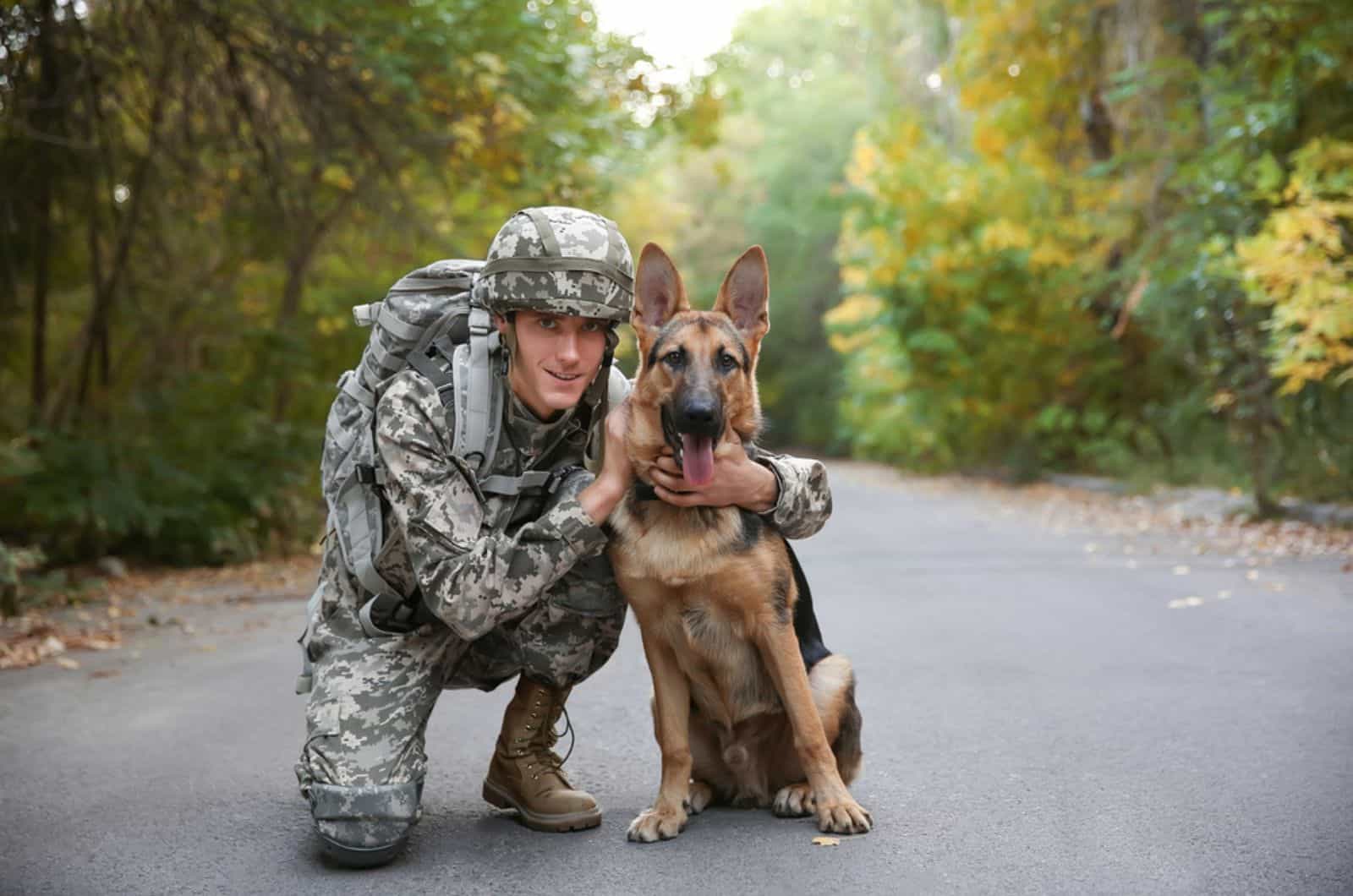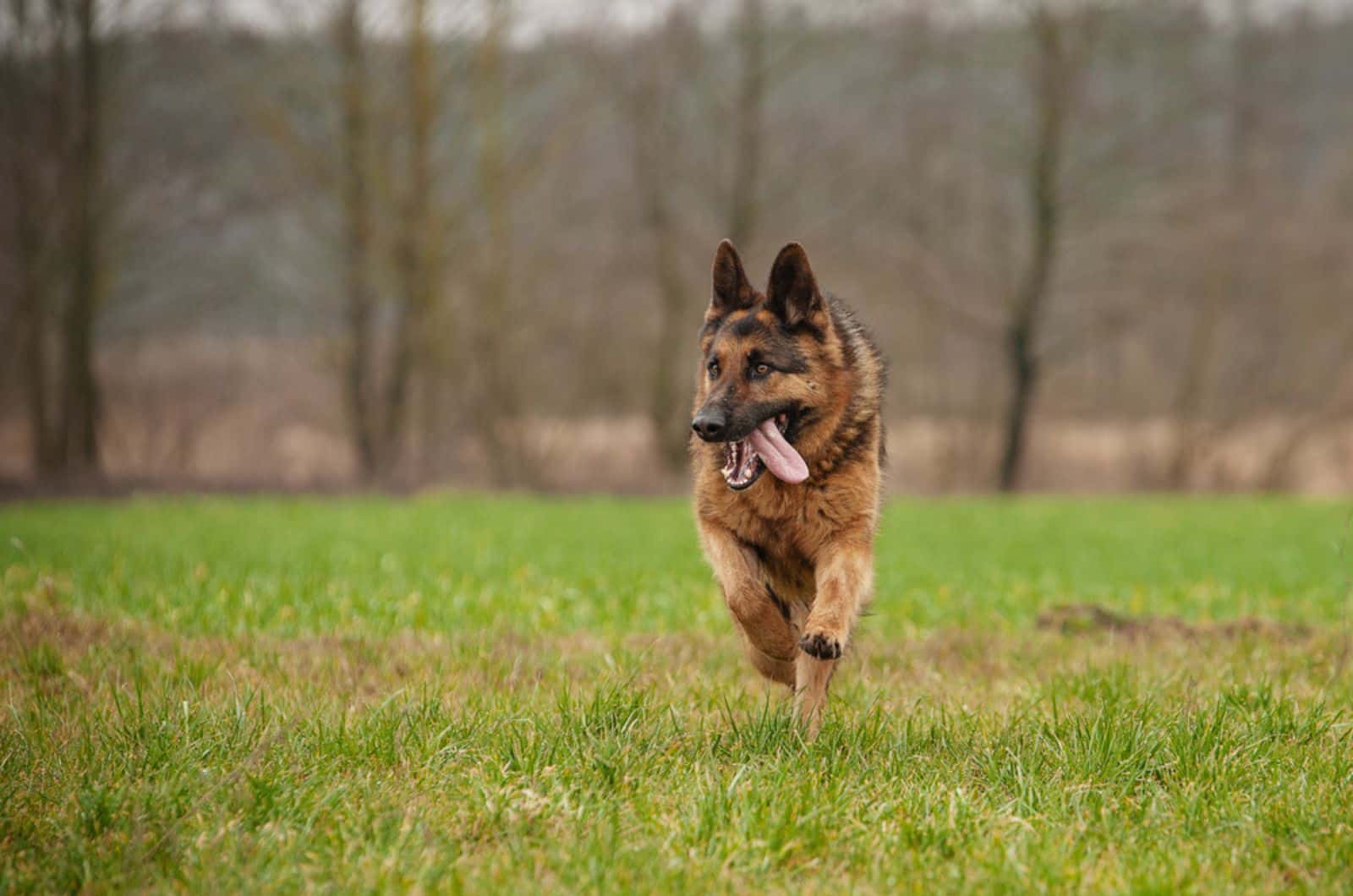Many people have been wondering what German Shepherds are bred for.
Let’s face it… this working dog breed has a reputation of being extremely intelligent, and it is among the most popular dog breeds according to the American Kennel Club.
However, keep in mind that poorly brought up GSDs might occasionally be anxious and alert. Overprotectiveness and violent conduct are dangers when combined with inadequate socialization and insufficient training.
If socialized with toddlers and other animals, the German shepherd dogs interact well with both, but because of their protective tendencies, they are often cautious around strangers.
German Shepherds were purposely developed to be intelligent, and they are today renowned for this quality. The breed placed third for intellect in the publication, ‘The Intelligence of Dogs’, by author Stanley Coren, following Border Collies as well as Poodles.
After only five trials, the author discovered that they could perform simple tasks, and they nearly always complied with the first instruction they were given.
GSDs are a popular choice for police dogs, search and rescue dogs, sheepdogs, guard dogs, dog show competitors, watchdogs, herding dogs, as well as family pets. They can pick up new tasks fast, and understand instructions better than some other large breeds of canines.
The First Steps Into Standardizing GSDs

Breed standardization efforts were underway throughout Europe in the 1850s. These dogs were brought up, generation after generation, in the exact same way in order to provide the best herders and dogs that guard the livestock that we know of today.
People who were working with livestock while living in Germany were in need of an excellent dog that would fulfill all their needs.
The dog that they were looking for needed to be not just a good herding dog, but also highly intelligent, fast, extremely strong, and capable of as many things as a dog can do. The end result was canines that performed these tasks, but varied in appearance and skill.
The Phylax Society was established in 1891 with the goal of developing standardized dog breeds in Germany to address these variances.
Due to persistent internal disagreements about the characteristics of dogs that the group should promote — some members thought dogs should be bred simply for working purposes, while others thought dogs should be bred for appearance. That Society broke down after a few years.
Who Helped Standardize The GSD We Know Of Today?
Despite failing to achieve their objective, the Phylax Society would have encouraged others to independently work toward dog breed standardization.
One of these ex-members was Max von Stephanitz, a prior veterinarian graduate and military captain. He was adamant that working dogs ought to be developed.
A dog by the name of Hektor Linksrhein was exhibited to Von Stephanitz in 1899 while he was watching a dog exhibition. Hektor, the result of several years of careful selection, perfectly embodied what Von Stephanitz thought a working dog ought to be.
He was impressed by the dog’s stamina, and so enamored by his cleverness, devotion, and elegance that he decided to buy him right away.
Following the dog’s acquisition, he changed his organization’s name to Organization for the German Shepherd Dog. As the first dog entered into the society’s breed registry, Hektor was proclaimed as the initial German Shepherd Dog.
So, What Are German Shepherds Bred For?

Breeders have worked hard to make the GSD a well-rounded working dog. Their double coat, strong outer coat, and warm undercoat is a strong shield against harsh winters, as well as being a characteristic of the breed standard.
Thanks to wonderful dog training and breeding the GSDs for certain purposes, these dogs have evolved from being well-rounded working dogs into certain fields of specialty.
The German Shepherd breed does not suffer any terrible health problems (just, in some instances, hip dysplasia, bloat, and rarely, degenerative myelopathy), which makes them overall healthy dogs that are ready to work.
As the years went by, and the GSD showed its incredible working dog habits in World War I and World War II, it became an integral part of the military and police force.
Also, they are great with livestock, so they also work as herding dogs. Because of their keen sense of smell, they are often employed as search and rescue dogs.
They will consider their human family, especially their owner, as their best friends because they will naturally be great watchdogs and guard dogs, which they were bred to be.
During WWI and WWII, this breed’s name was popular because they were guarding the army.
The former student of the Berlin Veterinary College, to whom we owe the GSD we know of today, did, in fact, say that this is an all-purpose working dog: this means that they can be thrown to work… literally everywhere and in everything.
Aside From Pets, They Are Also…

As working dogs, German Shepherds seem to be a particularly popular choice. They are particularly widely recognized for their police duties, where they are used to find criminals, patrol difficult areas, and capture suspects.
Furthermore, the military has employed thousands of German Shepherds. They are employed to alert soldiers to the existence of attackers or other dangers, and are typically trained for scout duty.
Military organizations have also trained German Shepherds to jump out of an airplane.
One of the most popular breeds in a range of scent-work roles is the German Shepherd Dog. These include, among others, search and rescue operations, corpse searches, narcotics detection, ignition source detection, and mine detecting canines.
Due to their excellent sense of smell as well as their capacity to focus in the face of disturbances, they are well qualified for these professions.
At one point, the GSD was almost always the breed of choice for people who needed a guide dog. German Shepherds are still being taught, but Labrador Retrievers and Golden Retrievers are becoming increasingly popular in recent periods.
They are a versatile breed that excels in this occupation, thanks to their profound sense of honor, mental prowess, courage, and commitment to their master.
GSDs have proven to be excellent herding dogs, herding anything from cows to sheep. To prevent sheep from straying and harming the fields, they are instructed to guard the borders of the livestock herd.
These abilities are evaluated in service dog trials, also referred to as HGH – herding utility hound instances, in Germany and throughout the world.
Popular GSDs Today

Numerous media outlets have highlighted German Shepherds. The first German Shepherd dog, which has become one of the movie stars, seems to have been Strongheart, the German Shepherd.
He was succeeded by Rin Tin Tin, who is generally regarded as the most renowned German Shepherd. The Hollywood Boulevard Walk of Fame features stars for both.
The famous Canadian show, ‘The Littlest Hobo’, featured German Shepherds. Ace, the Bat-Hound (Batman’s dog) first made an appearance in the Batman comics in 1955, and continued through 1964. However, his appearances were inconsistent from 1964 to 2007.
Inspector Rex is an Austrian TV drama, and Rex, a German Shepherd, is indeed the show’s titular police dog.
Thunderbolt dog, a German Shepherd, was a TV hero, and is featured in the Disney film, 101 Dalmatians II: Patch’s London Adventures from 2003.
Sam, a German Shepherd dog, is Robert Neville’s solitary friend in desolate New York City, in, I Am Legend, a 2007 Hollywood film starring Will Smith as microbiologist, Robert Neville.
The virus has spread across the city, leaving it infected with a deadly variant (rings a bell, huh?), and Neville is the only person left there. The central protagonist and his dog have a strong relationship that is depicted in the film.
Final Word
Strong hind legs, a sable coat, and alert pointy ears, and you still ask yourself, ‘What are German Shepherds bred for’? They are bred to be the best working dog out there.
By providing your GSD good dog food and supplements, they will have a long lifespan, as all breeds would, when properly taken care of.
The AKC says that the constant obedience training of generations of GSDs made them who they are today: the machines of the dog kingdom. To ensure that your German Shepherd will be healthy and happy, try to avoid breeders who practice inbreeding.
That firstly exhibited GSD Hektor, which later became Horand von Grafrath, which played a huge role in the GSD that we know of today, together with the Deutsche Schäferhunde (or the first Society of German Shepherd dogs).
Thanks to the strong ancestry and genetics, today, we enjoy the fruits of the breeders’ labors.
It is not just that these dogs are super fast, powerful, and agile, but they are also super loyal, extremely fearless when in the need to protect their loved ones, and the type of dog that will literally put their life at stake in order to protect yours.
There are so many beautiful things to be said about this dog breed, yet not a single bad thing to say about them, except that they do shed a lot. But, that is certainly not a problem when comparing the pros and the cons.
We concluded that these dogs are bred for, well, everything, but what is also important: these dogs weren’t bred to be lovable dogs that are gentle with kids, yet they have become that also.
A dog with a well-rounded personality will always be one of the most popular dog breeds in the world.















